Propaganda plays a crucial role in influencing public opinion by shaping beliefs and attitudes through various persuasive techniques. By leveraging emotional appeals and selective information, it aims to sway individuals towards specific viewpoints or actions. The effectiveness of these methods often hinges on psychological triggers, while cultural context and societal values significantly impact how propaganda is perceived and accepted across different communities.
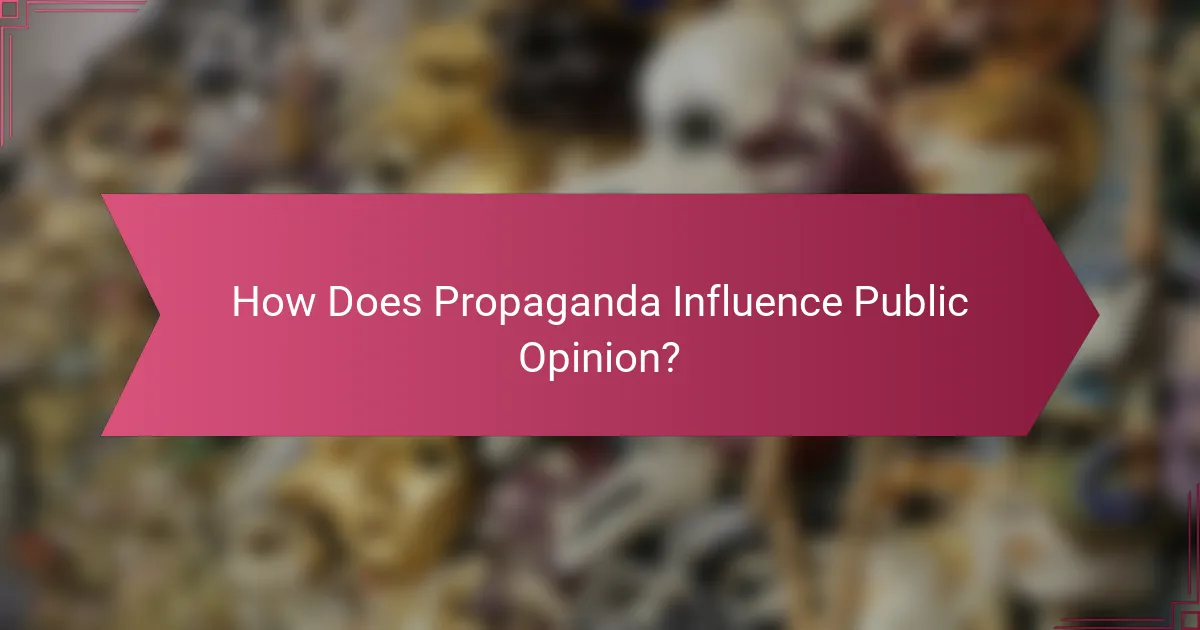
How Does Propaganda Influence Public Opinion?
Propaganda influences public opinion by shaping beliefs, attitudes, and perceptions through various techniques. It often employs emotional appeals and selective information to sway individuals towards a particular viewpoint or action.
Shaping perceptions
Shaping perceptions involves presenting information in a way that influences how people view certain issues or groups. This can be achieved through repeated messaging, which reinforces specific narratives and frames. For example, consistent portrayal of a political figure in a negative light can lead to widespread public distrust.
Visual elements, such as images and symbols, also play a crucial role in shaping perceptions. A powerful image can evoke strong feelings and create lasting impressions that affect public opinion.
Creating emotional responses
Creating emotional responses is a key tactic in propaganda, as emotions can drive decision-making more than rational thought. Techniques such as storytelling, dramatic visuals, and evocative language are used to elicit feelings like fear, hope, or anger.
For instance, advertisements that highlight personal stories of struggle can generate empathy and motivate action, such as donations or support for a cause. Understanding the emotional triggers can help individuals recognize when they are being influenced.
Framing issues
Framing issues involves presenting information in a specific context that highlights certain aspects while downplaying others. This can significantly alter public perception by influencing what people consider important. For example, framing a tax increase as a necessary investment in public services can lead to more favorable opinions than framing it as a burden on taxpayers.
Effective framing can also polarize opinions, making it difficult for individuals to see alternative viewpoints. Being aware of how issues are framed can help individuals critically assess the information presented to them.
Manipulating information
Manipulating information includes the selective presentation of facts, exaggeration, or outright falsehoods to influence public opinion. This can involve cherry-picking data that supports a particular narrative while ignoring contradictory evidence.
For example, during elections, candidates may highlight only their achievements while downplaying failures. Recognizing these tactics is essential for consumers of information to avoid being misled.
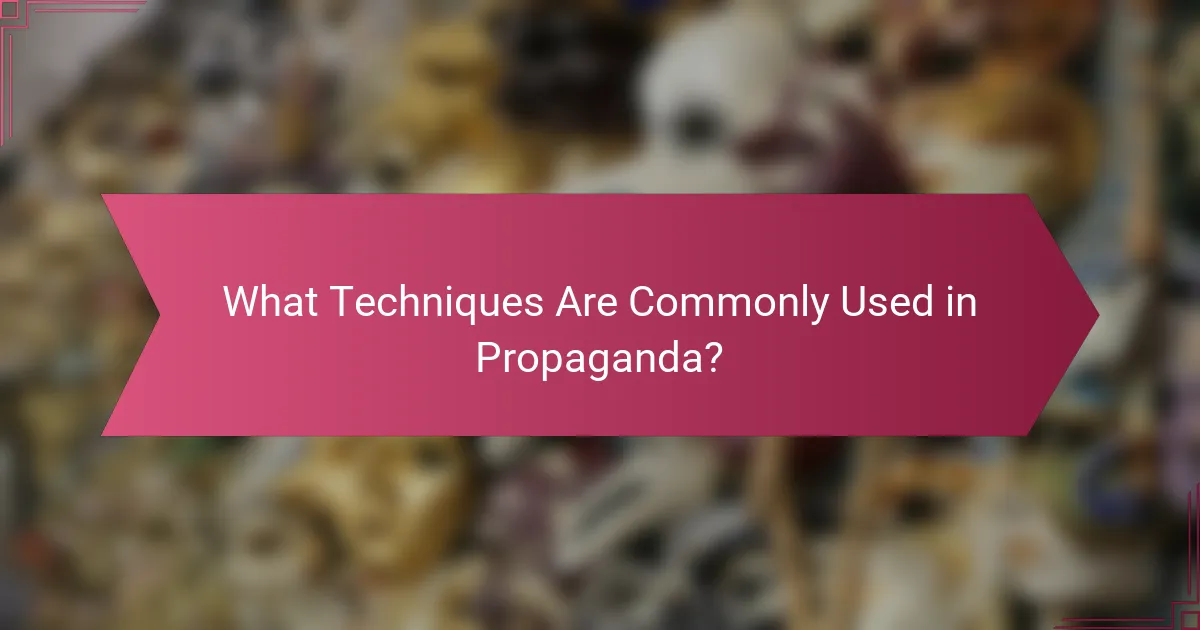
What Techniques Are Commonly Used in Propaganda?
Common techniques in propaganda include strategies designed to influence public perception and behavior. These methods often exploit psychological triggers to persuade audiences, making them effective in shaping opinions and mobilizing support.
Bandwagon effect
The bandwagon effect capitalizes on the human tendency to adopt beliefs or behaviors because others are doing so. This technique suggests that if a majority supports a particular idea or product, it must be valid or desirable.
For example, advertisements often highlight how many people use a product, implying that joining the crowd is the right choice. This can be particularly effective in political campaigns, where candidates emphasize their popularity to sway undecided voters.
Fear appeals
Fear appeals leverage anxiety or concern to motivate action or change behavior. By presenting a threat, such as economic instability or social unrest, propaganda can push individuals toward a specific viewpoint or action.
For instance, public health campaigns may use fear to encourage vaccinations by highlighting the dangers of diseases. However, it’s crucial to balance fear with solutions; otherwise, audiences may become desensitized or resistant.
Testimonial endorsements
Testimonial endorsements involve influential figures or everyday individuals vouching for a product, idea, or candidate. This technique builds credibility and trust, as people often relate to or admire these endorsers.
For example, celebrities endorsing a charity can significantly boost its visibility and donations. However, the effectiveness of this method can diminish if the audience perceives the endorsement as insincere or purely transactional.
Repetition and slogans
Repetition and slogans reinforce messages by repeatedly presenting them in a catchy or memorable format. This technique helps embed ideas into public consciousness, making them easier to recall and accept.
Political campaigns often use simple slogans to encapsulate their messages, such as “Make America Great Again.” Effective slogans are concise and resonate emotionally, ensuring they stick in the minds of voters. However, overuse can lead to fatigue, so balance is key.
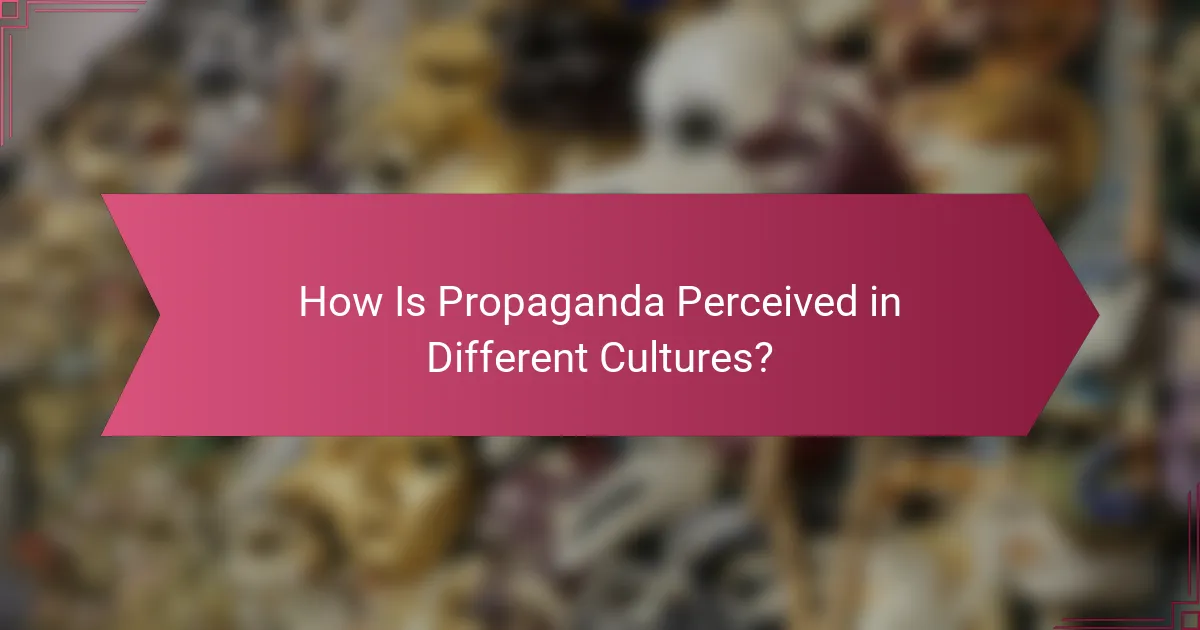
How Is Propaganda Perceived in Different Cultures?
Propaganda is perceived differently across cultures, influenced by historical context, societal values, and media consumption habits. These factors shape how messages are interpreted and accepted within various communities.
Cultural context impacts perception
Cultural norms and values significantly affect how propaganda is received. For instance, collectivist societies may view state-sponsored messages as beneficial for the community, while individualistic cultures might see them as intrusive or manipulative. Understanding these cultural nuances is crucial for effective communication.
Additionally, symbols and language used in propaganda can resonate differently based on cultural backgrounds. What is persuasive in one culture may be seen as offensive or irrelevant in another, highlighting the need for tailored messaging.
Historical influences on interpretation
Historical events shape how propaganda is interpreted in various cultures. Countries with a history of authoritarian regimes may be more skeptical of government messages, while those with a tradition of democratic discourse might be more accepting. This historical lens can create a lasting impact on public perception.
For example, nations that experienced significant propaganda during wartime may have a heightened awareness of manipulation tactics, leading to critical consumption of media. Recognizing these historical influences can help in crafting messages that are sensitive to past experiences.
Media landscape variations
The media landscape plays a vital role in how propaganda is disseminated and perceived. In countries with diverse media outlets, audiences may encounter multiple viewpoints, fostering critical analysis of propaganda. Conversely, in regions with state-controlled media, propaganda may dominate public discourse, limiting alternative perspectives.
Moreover, the rise of digital media has transformed how propaganda spreads, allowing for rapid dissemination and targeted messaging. Understanding the local media environment is essential for assessing the potential impact of propaganda on public opinion.
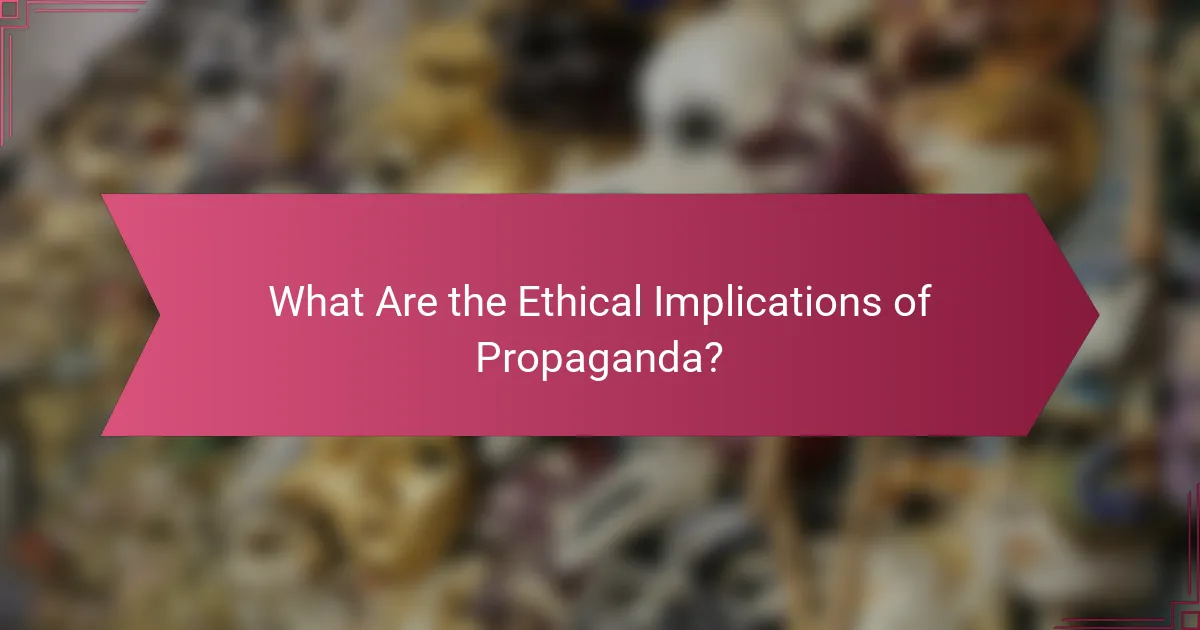
What Are the Ethical Implications of Propaganda?
The ethical implications of propaganda revolve around its potential to manipulate public opinion and influence behaviors, often without transparency. While it can be used for positive social change, it can also lead to misinformation and the erosion of trust in institutions.
Manipulation vs. persuasion
Manipulation involves influencing someone’s beliefs or actions through deceptive or coercive means, whereas persuasion relies on logical arguments and emotional appeals without deceit. Understanding this distinction is crucial, as manipulation can undermine autonomy and informed decision-making.
For example, a political campaign may use persuasive techniques by highlighting facts and values, while a manipulative approach might involve spreading false information to mislead voters. Recognizing these tactics helps individuals critically evaluate the messages they encounter.
Impact on democracy
Propaganda can significantly affect democratic processes by shaping public perceptions and opinions, often skewing them in favor of specific agendas. When citizens are exposed to biased information, their ability to make informed choices during elections diminishes.
In some cases, propaganda can lead to polarization, where opposing groups become entrenched in their views, making compromise and dialogue difficult. This undermines the democratic principle of informed citizen participation and can lead to social unrest.
Responsibility of media
The media plays a critical role in disseminating information and shaping public discourse, thus carrying a significant ethical responsibility. Journalists and media outlets must strive for accuracy, fairness, and transparency to foster trust and informed citizenship.
To fulfill this responsibility, media organizations should adhere to established ethical standards, such as fact-checking and providing context. Audiences should also be encouraged to critically assess media sources and seek diverse perspectives to combat propaganda’s effects.
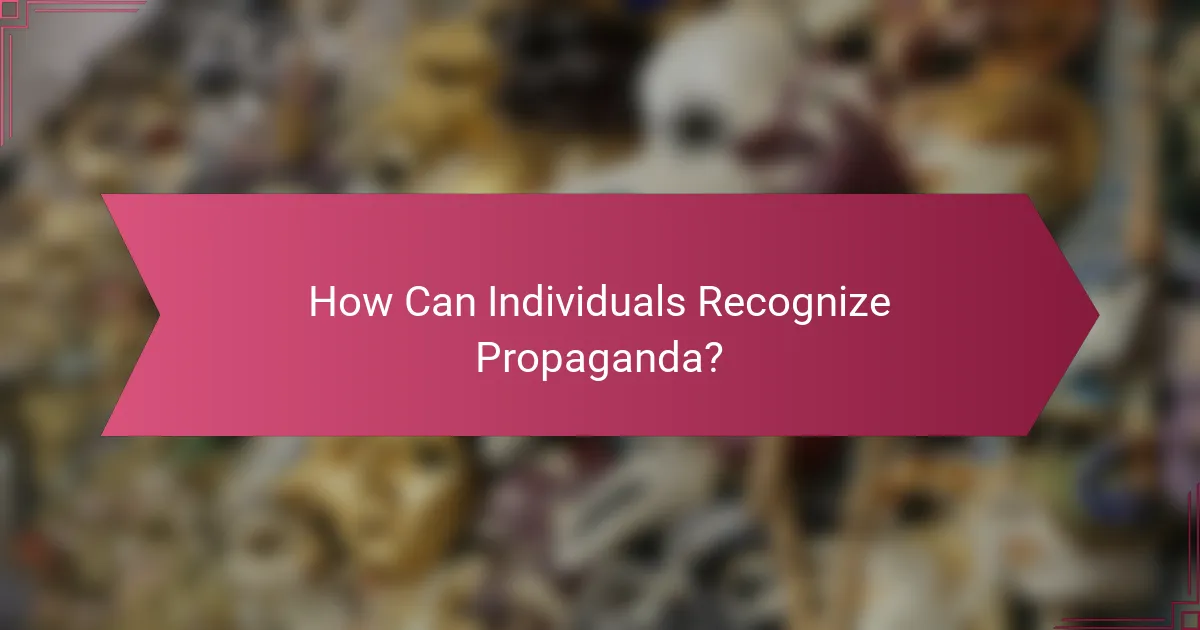
How Can Individuals Recognize Propaganda?
Individuals can recognize propaganda by being aware of its characteristics and techniques, which often aim to manipulate opinions or beliefs. Understanding these elements can help people critically evaluate the information they encounter.
Critical thinking skills
Developing critical thinking skills is essential for recognizing propaganda. This involves analyzing arguments, questioning assumptions, and evaluating evidence. By practicing skepticism and considering multiple perspectives, individuals can better discern the intent behind the information presented.
Engaging in discussions and debates can also enhance critical thinking. This practice encourages individuals to articulate their thoughts clearly and consider counterarguments, which can reveal biases in the information they consume.
Identifying biased sources
Identifying biased sources is crucial in recognizing propaganda. Look for signs of partiality, such as emotionally charged language or one-sided arguments. Reliable sources typically present balanced viewpoints and cite credible evidence.
To assess a source’s credibility, consider its reputation, the expertise of the authors, and the quality of the evidence provided. Cross-referencing information with multiple sources can help confirm its reliability and reduce the risk of being misled.
Fact-checking techniques
Fact-checking techniques are vital for verifying claims and identifying propaganda. Use reputable fact-checking websites to assess the accuracy of information. These platforms often provide context and sources that can clarify misleading statements.
When fact-checking, consider the date of the information and whether it is still relevant. Additionally, be cautious of confirmation bias, where individuals seek out information that supports their existing beliefs. Aim to approach fact-checking with an open mind to ensure a comprehensive understanding.

What Role Does Social Media Play in Propaganda?
Social media serves as a powerful tool for propaganda by enabling rapid dissemination and amplification of messages to vast audiences. Its interactive nature allows for engagement and manipulation of public perception in real-time.
Amplification of messages
Social media platforms amplify propaganda messages by leveraging algorithms that prioritize content based on user engagement. This means that sensational or emotionally charged posts are more likely to be seen and shared, increasing their reach significantly.
For example, a political campaign may use targeted ads on platforms like Facebook or Instagram to spread specific narratives, reaching demographics that align with their messaging. This targeted approach can lead to a higher likelihood of influencing public opinion and behavior.
To effectively counteract propaganda, individuals should critically evaluate the sources of information they encounter on social media. Checking the credibility of the content, looking for corroborating evidence, and being aware of echo chambers can help mitigate the impact of misleading messages.
